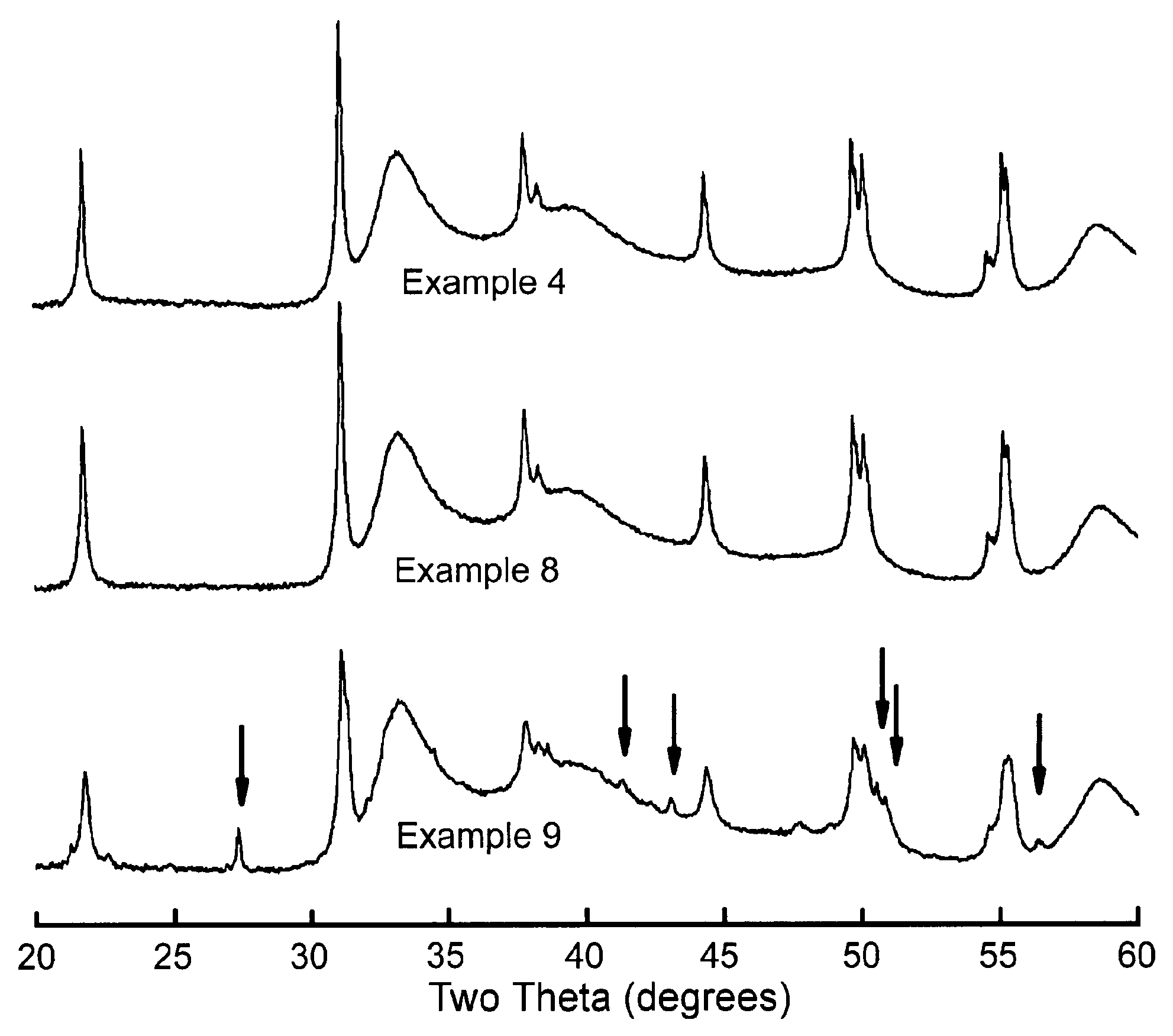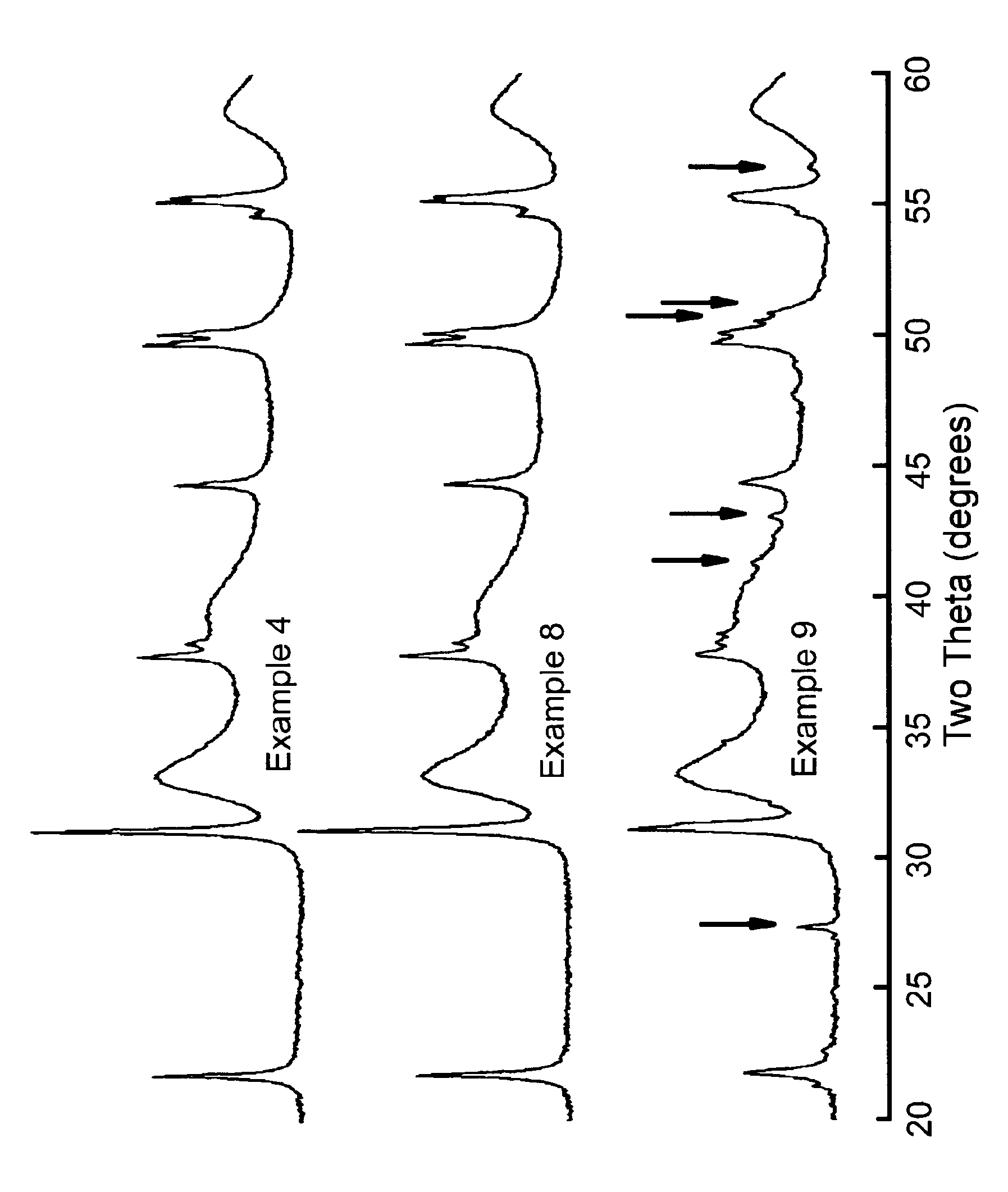Method for the start-up of a catalytic process
a catalytic process and catalytic technology, applied in the field of catalytic process start-up, can solve the problems of undesirable contaminants in the hydrocarbon stream of said product, the use of full-range feed during start-up is usually less than ideal, and the contamination of other catalysts in the catalyst bed
- Summary
- Abstract
- Description
- Claims
- Application Information
AI Technical Summary
Benefits of technology
Problems solved by technology
Method used
Image
Examples
example 1
Catalyst
[0061]A bulk metal catalyst was prepared by contacting suitable nickel and molybdenum salts slurried in water at 80° C. with ammonia and Sipernat 50 (Sipernat is a trademark). After 30 minutes digestion time, the slurry was spray-dried. The obtained powder was rewetted with water, and mulled in a mix muller until a suitable mix for extrusion was obtained. The obtained mix was extruded into a trilobe form. The thus-obtained green extrudates were dried at 120° C. for 1 hour, and calcined at 300° C. for a further hour.
[0062]The elemental structure of the solid obtained in this Example was (Ni)1.0(Mo)1.0(Si)0.9(O)5.8 with a nominal catalyst composition of Ni—Mo—SiO2 (27 wt %, 53 wt %, 20 wt % on oxide basis, referring to the weight % of NiO, MoO3 and SiO2 in the sample).
[0063]In all the Examples below, unless otherwise, stated, the straight run gas oil used was a mixture of Arabian heavy and Arabian light gas oils, from a refinery stream, with the features shown in Table 1:
[0064...
example 2
Comparative
Start-Up
[0066]After loading, the catalyst was wetted by contacting it with straight run gas oil at a sufficiently high volumetric space velocity, until breakthrough of the wetting feed was observed. Upon breakthrough, the volumetric space velocity was set to 1.5 h−1 and H2 and H2S gas were fed into the reactor. The hydrogen gas to feed ratio was set at 200 Nl·kg−1, while the pressure was increased to 40 bar hydrogen partial pressure. The H2S gas to feed ratio was set at 3 Nl·kg−1.
[0067]The following temperature program was applied to complete the conversion of the oxidic precursor to the catalytically active sulfided form: The temperature was increased from room temperature to 130° C. at a ramping rate of 20° C. / hour. After 10 hours hold time, the temperature was further increased to 280° C. at the same ramping rate. After 10 hours additional hold time, the temperature was increased to the reaction temperature of 345° C. Once this temperature was reached, the flow of H2S ...
example 3
Comparative
Start-Up
[0069]After loading of the catalyst, H2 was fed into the reactor and the pressure was set to 40 bar hydrogen partial pressure. The straight run gas oil feed was not immediately introduced to the reactor. The temperature was raised to 135° C. After 2 hours hold time, the straight run gas oil was introduced at 135° C. and at sufficiently high volumetric space velocities to ensure proper wetting. Upon breakthrough, the volumetric space velocity was set to 1.5 h−1. The hydrogen gas to feed ratio was set to 200 Nl·kg−1. The temperature was held at 135° C. After not longer than 5 hours time in total at 135° C., the temperature was further increased to 280° C. at a 30° C. / hour ramping rate. After 10 hours hold time, the temperature was again increased to the reaction temperature of 345° C. H2S was not admitted to the reactor throughout the whole start-up process.
Activity Testing
[0070]The reaction conditions and feed used to evaluate the catalytic activity were identical ...
PUM
| Property | Measurement | Unit |
|---|---|---|
| molar ratio | aaaaa | aaaaa |
| temperature | aaaaa | aaaaa |
| temperature | aaaaa | aaaaa |
Abstract
Description
Claims
Application Information
 Login to View More
Login to View More - R&D
- Intellectual Property
- Life Sciences
- Materials
- Tech Scout
- Unparalleled Data Quality
- Higher Quality Content
- 60% Fewer Hallucinations
Browse by: Latest US Patents, China's latest patents, Technical Efficacy Thesaurus, Application Domain, Technology Topic, Popular Technical Reports.
© 2025 PatSnap. All rights reserved.Legal|Privacy policy|Modern Slavery Act Transparency Statement|Sitemap|About US| Contact US: help@patsnap.com


